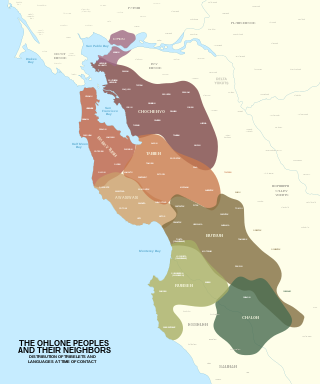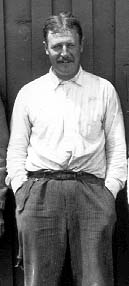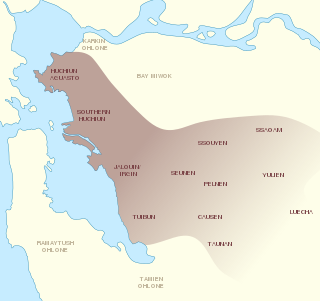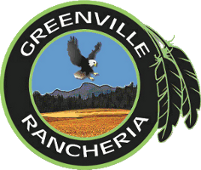Related Research Articles

The Native American Graves Protection and Repatriation Act (NAGPRA), Pub. L. 101-601, 25 U.S.C. 3001 et seq., 104 Stat. 3048, is a United States federal law enacted on November 16, 1990.

The Ohlone, formerly known as Costanoans, were a Native American people of the Northern California coast. When Spanish explorers and missionaries arrived in the late 18th century, the Ohlone inhabited the area along the coast from San Francisco Bay through Monterey Bay to the lower Salinas Valley. At that time they spoke a variety of related languages. The Ohlone languages make up a sub-family of the Utian language family. Older proposals place Utian within the Penutian language phylum, while newer proposals group it as Yok-Utian.
The Bay Miwok are a cultural and linguistic group of Miwok, a Native American people in Northern California who live in Contra Costa County. They joined the Franciscan mission system during the early nineteenth century, suffered a devastating population decline, and lost their language as they intermarried with other native California ethnic groups and learned the Spanish language.

Repatriation is the return of a thing or person to its country of origin. The term may refer to non-human entities, such as converting a foreign currency into the currency of one's own country, as well as the return military personnel to their place of origin following a war. It also applies to diplomatic envoys, international officials as well as expatriates and migrants in time of international crisis. For refugees, asylum seekers and illegal migrants, repatriation can mean either voluntary return or deportation.

Alfred Vincent Kidder was an American archaeologist considered the foremost of the southwestern United States and Mesoamerica during the first half of the 20th century. He saw a disciplined system of archaeological techniques as a means to extend the principles of anthropology into the prehistoric past and so was the originator of the first comprehensive, systematic approach to North American archaeology.
Archaeological ethics refers to the moral issues raised through the study of the material past. It is a branch of the philosophy of archaeology. This article will touch on human remains, the preservation and laws protecting remains and cultural items, issues around the globe, as well as preservation and ethnoarchaeology.

Moundville Archaeological Site, also known as the Moundville Archaeological Park, is a Mississippian culture archaeological site on the Black Warrior River in Hale County, near the modern city of Tuscaloosa, Alabama. Extensive archaeological investigation has shown that the site was the political and ceremonial center of a regionally organized Mississippian culture chiefdom polity between the 11th and 16th centuries. The archaeological park portion of the site is administered by the University of Alabama Museums and encompasses 185 acres (75 ha), consisting of 29 platform mounds around a rectangular plaza.

The National Museum of the American Indian Act was enacted on November 28, 1989, as Public Law 101-185. The law established the National Museum of the American Indian as part of the Smithsonian Institution. The law also required the Secretary of the Smithsonian to prepare an inventory of all Indian and Native Hawaiian human remains and funerary objects in Smithsonian collections, as well as expeditiously return these items upon the request of culturally affiliated federally recognized Indian tribes and Native Hawaiian organizations.

Mission Indians are the indigenous peoples of California who lived in Southern California and were forcibly relocated from their traditional dwellings, villages, and homelands to live and work at 15 Franciscan missions in Southern California and the Asistencias and Estancias established between 1796 and 1823 in the Las Californias Province of the Viceroyalty of New Spain.

The Chochenyo are one of the divisions of the indigenous Ohlone (Costanoan) people of Northern California. The Chochenyo reside on the east side of the San Francisco Bay, primarily in what is now Alameda County, and also Contra Costa County, from the Berkeley Hills inland to the western Diablo Range.

The Phoebe A. Hearst Museum of Anthropology is an anthropology museum located in Berkeley, California, on the University of California, Berkeley, campus. The museum houses Cafe Ohlone, the only restaurant in the world to serve Ohlone cuisine.
The Advisory Council on California Indian Policy (ACCIP) was created by an act of the United States Congress and signed by President George H. W. Bush on October 14, 1992. It provided for the creation of a special advisory council made up of eighteen members with the purpose of studying the unique problems that California Native Americans face in receiving federal acknowledgment. Additionally, they were given the task of studying the social and economic conditions of California natives, “characterized by, among other things, alcohol and substance abuse, critical health problems, family violence and child abuse, lack of educational and employment opportunities, and significant barriers to tribal economic development.” Under the provisions for the act, the Advisory Council was to make recommendations regarding California Indian policy to the Congress and the Departments of the Interior and of Health and Human Services.
The Association on American Indian Affairs is a nonprofit human rights charity located in Rockville, Maryland. Founded in 1922, it is dedicated to protecting the rights of Native Americans.
Maria Darlene Pearson or Hai-Mecha Eunka was an activist who has successfully challenged the legal treatment of Native American remains. A member of the Turtle Clan of the Yankton Sioux, she was one of the primary catalysts for the creation of the Native American Graves Protection and Repatriation Act (NAGPRA). Her actions led to her being called "the Founding Mother of the modern Indian repatriation movement" and "the Rosa Parks of NAGPRA".

Indigenous peoples of California, commonly known as Indigenous Californians or Native Californians, are a diverse group of nations and peoples that are indigenous to the geographic area within the current boundaries of California before and after the colonization of Europeans. There are currently 109 federally recognized tribes in the state and over forty self-identified tribes or tribal bands that have applied for federal recognition. California has the second-largest Native American population in the United States.

The Greenville Rancheria of Maidu Indians of California is a federally recognized tribe of Maidu people in Plumas and Tehama Counties, California.
The Tuqan Man consists of human remains found on San Miguel Island off the coast of California in 2005. The skull and bones of a man buried between 9,800 and 10,200 years ago were exposed by beach erosion on this westernmost Channel Islands. The remains were encountered and preserved in 2005 by University of Oregon archaeologists. The remains were dated by way of radiocarbon dating and evaluation of artifacts which had been intentionally buried with him. Analysis of the bones indicated that he was in his forties when he died, and had spent time some distance east of what is now the Santa Barbara coastal region. It was not possible to extract the Tuqan Man's DNA, though increasingly better testing techniques and methods became available and were utilized over the 12 years that passed after his original discovery. The remains return to the island was delayed by resolution of tribal identification and ownership issues contingent on resolution of the precedent-setting Kennewick Man case from Washington State. Under procedures in accordance with the Native American Graves Protection and Repatriation Act (NAGPRA), in May, 2018, they were restored to the claiming Chumash tribe, for reburial on the island. The Chumash people had long occupied the island before the arrival of the first European explorers, and the find was given the place name of the island in the Chumash language.

Vincent Medina is a Chochenyo Ohlone indigenous rights, language, and food activist. He is a member of the Muwekma Ohlone Tribe and co-founded Cafe Ohlone, an Ohlone restaurant in Berkeley, California which serves indigenous cuisine made with native ingredients sourced from the San Francisco and Monterey Bay Areas. As of 2019 he was serving on the Muwekma tribal council, and he is Capitán of the ‘Itmay Cultural Association. He is also a member of the Board of Directors of Advocates for Indigenous California Language Survival. Medina speaks English, Spanish, and Chochenyo.
Funerary archaeology is a branch of archaeology that studies the treatment and commemoration of the dead. It includes the study of human remains, their burial contexts, and from single grave goods through to monumental landscapes. Funerary archaeology might be considered a sub-set of the study of religion and belief. A wide range of expert areas contribute to funerary archaeology, including epigraphy, material culture studies, thanatology, human osteology, zooarchaeology and stable isotope analysis.
Adeline Mary Sam Fredin (1934–2018) was an American archaeologist, tribal member, Director and Tribal Historic Preservation Officer of the Confederated Tribes of the Colville Reservation. She is best known as one of the first 12 accredited Tribal Heritage Preservation Officers in the United States and for her contributed efforts to the repatriation of Kennewick Man and furthering tribal engagement as an Indian Country leader in Cultural Resource Management. Fredin was a self-taught pioneer in the protection of Native American heritage and rights to the preservation of prehistoric artifacts and human remains. The Washington State Department of Archaeology and Historic Preservation describes Fredin's contributions to the field of archaeology as formative to the relationship between anthropology and tribal histories. Fredin was rumored a force to be reckoned with who maintained relationships with the Secretary of Interior, the White House and the Pentagon, perceived as an attorney of sorts when it came to Indian law.
References
- 1 2 3 Orona, Brittani R; Esquivido, Vanessa D (2020-10-07). "Continued Disembodiment: NAGPRA, CAL NAGPRA, and Recognition". Humboldt Journal of Social Relations. 1 (42): 50–68. doi: 10.55671/0160-4341.1132 . ISSN 0160-4341.
- ↑ Gulliford, Andrew (1996-10-01). "Bones of Contention: The Repatriation of Native American Human Remains". The Public Historian. 18 (4): 119–143. doi:10.2307/3379790. ISSN 0272-3433.
- ↑ "Native American Graves Protection and Repatriation in California State Parks". CA State Parks. Retrieved 2023-05-16.
- ↑ FFORDE, CRESSIDA, "Collection, repatriation and identity", THE DEAD AND THEIR POSSESSIONS, Abingdon, UK: Taylor & Francis, retrieved 2023-05-16
- ↑ Time Has Many Voices: The Excavation of a Muwekma Ohlone Village | Time Has Many Voices: The Excavation of a Muwekma Ohlone Vil | PBS , retrieved 2023-05-16
- ↑ Kim, Jieun; Steadman, Dawnie W. (2014). "A Review of Codes of Ethics in the United States and Ethical Dilemmas Surrounding the Native American Graves Protection and Repatriation Act (NAGPRA)". Korean Journal of Physical Anthropology. 27 (2): 47. doi:10.11637/kjpa.2014.27.2.47. ISSN 1225-150X.